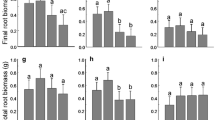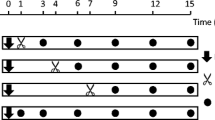Abstract
Main conclusion
In Nicotiana attenuata seedlings, simulated herbivo ry by the specialist Manduca sexta decreases root growth and partitioning of recent photoassimilates to roots in contrast to increased partitioning reported for older plants.
Root elongation rate in Nicotiana attenuata has been shown to decrease after leaf herbivory, despite reports of an increased proportion of recently mobilized photoassimilate being delivered towards the root system in many species after similar treatments. To study this apparent contradiction, we measured the distribution of recent photoassimilate within root tissues after wounding or simulated herbivory of N. attenuata leaves. We found no contradiction: herbivory reduced carbon delivery to root tips. However, the speed of phloem transport in both shoot and root, and the delivery of recently assimilated carbon to the entire root system, declined after wounding or simulated herbivory, in contrast with the often-reported increase in root partitioning. We conclude that the herbivory response in N. attenuata seedlings is to favor the shoot and not bunker carbon in the root system.





Similar content being viewed by others
Abbreviations
- CON:
-
Control treatment
- V tip :
-
Velocity of the root tip
- WOS:
-
Simulated herbivory treatment
- WW:
-
Wounding treatment
References
Acosta IF, Gasperini D, Chételat A, Stolz S, Santuari L, Farmer EE (2013) Role of NINJA in root jasmonate signaling. Proc Natl Acad Sci USA 110:15473–15478
Arnold T, Schultz J (2002) Induced sink strength as a prerequisite for induced tannin biosynthesis in developing leaves of Populus. Oecologia 130:585–593
Arnold T, Appel H, Patel V, Stocum E, Kavalier A, Schultz J (2004) Carbohydrate translocation determines the phenolic content of Populus foliage: a test of the sink-source model of plant defense. New Phytol 164:157–164
Babst BA, Ferrieri RA, Gray DW, Lerdau M, Schlyer DJ, Schueller M, Thorpe MR, Orians CM (2005) Jasmonic acid induces rapid changes in carbon transport and partitioning in Populus. New Phytol 167:63–72
Babst BA, Ferrieri RA, Thorpe MR, Orians CM (2008) Lymantria dispar herbivory induces rapid changes in carbon transport and partitioning in Populus nigra. Entomol Exp Appl 128:117–125
Ballaré CL (2014) Light regulation of plant defense. Annu Rev Plant Biol 65:335–363
Barton KE (2008) Phenotypic plasticity in seedling defense strategies: compensatory growth and chemical induction. Oikos 117:917–925
Barton KE, Hanley ME (2013) Seedling-herbivore interactions: insights into plant defence and regeneration patterns. Ann Bot 112:643–650
Boege K, Marquis RJ (2005) Facing herbivory as you grow up: the ontogeny of resistance in plants. Trends Ecol Evol 20:441–448
Diezel C, Allmann S, Baldwin IT (2011) Mechanisms of optimal defense patterns in Nicotiana attenuata: flowering attenuates herbivory-elicited ethylene and jasmonate signaling. J Integr Plant Biol 53:971–983
Ferrieri AP, Appel H, Ferrieri RA, Schultz JC (2012) Novel application of 2-[(18)F]fluoro-2-deoxy-d-glucose to study plant defenses. Nucl Med Biol 39:1152–1160
Ferrieri AP, Agtuca B, Appel HM, Ferrieri RA, Schultz JC (2013) Temporal changes in allocation and partitioning of new carbon as (11)C elicited by simulated herbivory suggest that roots shape aboveground responses in Arabidopsis. Plant Physiol 161:692–704
Fragoso V, Rothe E, Baldwin IT, Kim S (2014) Root jasmonic acid synthesis and perception regulate folivore-induced shoot metabolites and increase Nicotiana attenuata resistance. New Phytol 202:1335–1345
Frost CJ, Hunter MD (2008) Herbivore-induced shifts in carbon and nitrogen allocation in red oak seedlings. New Phytol 178:835–845
Gómez S, Ferrieri RA, Schueller M, Orians CM (2010) Methyl jasmonate elicits rapid changes in carbon and nitrogen dynamics in tomato. New Phytol 188:835–844
Gómez S, Steinbrenner AD, Osorio S, Schueller M, Ferrieri RA, Fernie AR, Orians CM (2012) From shoots to roots: transport and metabolic changes in tomato after simulated feeding by a specialist lepidopteran. Entomol Exp Appl 144:101–111
Gulati J, Baldwin IT, Gaquerel E (2014) The roots of plant defenses: integrative multivariate analyses uncover dynamic behaviors of gene and metabolic networks of roots elicited by leaf herbivory. Plant J 77:880–892
Hammer O, Harper DAT, Ryan PD (2001) Past: paleontological statistics software package for education and data analysis. Palaeontol Electron 4:9
Hanik N, Gómez S, Best M, Schueller M, Orians CM, Ferrieri RA (2010) Partitioning of new carbon as 11C in Nicotiana tabacum reveals insight into methyl jasmonate induced changes in metabolism. J Chem Ecol 36:1058–1067
Hansen CF, Garcia MB, Ehlers BK (2013) Water availability and population origin affect the expression of the tradeoff between reproduction and growth in Plantago coronopus. J Evol Biol 26:993–1002
Henkes GJ, Thorpe MR, Minchin PEH, Schurr U, Röse USR (2008) Jasmonic acid treatment to part of the root system is consistent with simulated leaf herbivory, diverting recently assimilated carbon towards untreated roots within an hour. Plant Cell Environ 31:1229–1236
Holland JN, Cheng W, Crossley DA (1996) Herbivore-induced changes in plant carbon allocation: assessment of below-ground C fluxes using carbon-14. Oecologia 107:87–94
Hukin D, Doering-Saad C, Thomas CR, Pritchard J (2002) Sensitivity of cell hydraulic conductivity to mercury is coincident with symplasmic isolation and expression of plasmalemma aquaporin genes in growing maize roots. Planta 215:1047–1056
Hummel GM, Naumann M, Schurr U, Walter A (2007) Root growth dynamics of Nicotiana attenuata seedlings are affected by simulated herbivore attack. Plant Cell Environ 30:1326–1336
Kaplan I, Halitschke R, Kessler A, Rehill BJ, Sardanelli S, Denno RF (2008) Physiological integration of roots and shoots in plant defense strategies links above- and belowground herbivory. Ecol Lett 11:841–851
Kim S, Yon F, Gaquerel E, Gulati J, Baldwin IT (2011) Tissue specific diurnal rhythms of metabolites and their regulation during herbivore attack in a native tobacco, Nicotiana attenuata. PLoS One 6:e26214
Machado RAR, Ferrieri AP, Robert CAM, Glauser G, Kallenbach M, Baldwin IT, Erb M (2013) Leaf-herbivore attack reduces carbon reserves and regrowth from the roots via jasmonate and auxin signaling. New Phytol 200:1234–1246
Massad TJ, Trumbore SE, Ganbat G, Reichelt M, Unsicker S, Boeckler A, Gleixner G, Gershenzon J, Ruehlow S (2014) An optimal defense strategy for phenolic glycoside production in Populus trichocarpa––isotope labeling demonstrates secondary metabolite production in growing leaves. New Phytol 203:607–619
Minchin PEH, Thorpe MR (2003) Using the short-lived isotope 11C in mechanistic studies of photosynthate transport. Funct Plant Biol 30:831–841
Minchin PEH, Thorpe MR, Farrar JF (1993) A simple mechanistic model of phloem transport which explains sink priority. J Exp Bot 44:947–955
Minchin PEH, Thorpe MR, Farrar JF (1994) Short-term control of root: shoot partitioning. J Exp Bot 45:615–622
Mousavi Seyed A R, Chauvin A, Pascaud F, Kellenberger S, Farmer EE (2013) GLUTAMATE RECEPTOR-LIKE genes mediate leaf-to-leaf wound signalling. Nature 500:422–426
Nabity PD, Zavala JA, DeLucia EH (2009) Indirect suppression of photosynthesis on individual leaves by arthropod herbivory. Ann Bot 103:655–663
Ohnmeiss TE, Baldwin IT (2000) Optimal defense theory predicts the ontogeny of an induced nicotine defense. Ecology 81:1765–1783
Orians CM, Thorn A, Gómez S (2011) Herbivore-induced resource sequestration in plants: why bother? Oecologia 167:1–9
Peterson RKD, Higley LG (1993) Arthropod injury and plant gas exchange: current understandings and approaches for synthesis. Trends Agric Sci 1:93–100
Philippe RN, Ralph SG, Mansfield SD, Bohlmann J (2010) Transcriptome profiles of hybrid poplar (Populus trichocarpa × deltoides) reveal rapid changes in undamaged, systemic sink leaves after simulated feeding by forest tent caterpillar (Malacosoma disstria). New Phytol 188:787–802
Pickard WF, Minchin PEH, Thorpe MR (1993) Leaf export and partitioning changes induced by short-term inhibition of phloem transport. J Exp Bot 44:1491–1496
Poorter H, Niklas KJ, Reich PB, Oleksyn J, Poot P, Mommer L (2012a) Biomass allocation to leaves, stems and roots: meta-analyses of interspecific variation and environmental control. New Phytol 193:30–50
Poorter H, Fiorani F, Stitt M, Schurr U, Finck A, Gibon Y, Usadel B, Munns R, Atkin OK, Tardieu F, Pons TL (2012b) The art of growing plants for experimental purposes: a practical guide for the plant biologist. Funct Plant Biol 39:821–838
Pritchard J, Tomos AD, Farrar JF, Minchin PEH, Gould N, Paul MJ, MacRae EA, Ferrieri RA, Gray DW, Thorpe MR (2004) Turgor, solute import and growth in maize roots treated with galactose. Funct Plant Biol 31:1095–1103
Robert CAM, Veyrat N, Glauser G, Marti G, Doyen GR, Villard N, Gaillard MDP, Köllner TG, Giron D, Body M, Babst BA, Ferrieri RA, Turlings TCJ, Erb M (2012) A specialist root herbivore exploits defensive metabolites to locate nutritious tissues. Ecol Lett 15:55–64
Robert CAM, Ferrieri RA, Schirmer S, Babst BA, Schueller MJ, Machado RAR, Arce CCM, Hibbard BE, Gershenzon J, Turlings TCJ, Erb M (2014) Induced carbon reallocation and compensatory growth as root herbivore tolerance mechanisms. Plant Cell Environ 37:2613–2622
Salvador-Recatalà V, Tjallingii WF, Farmer EE (2014) Real-time, in vivo intracellular recordings of caterpillar-induced depolarization waves in sieve elements using aphid electrodes. New Phytol 203:674–684
Sardans J, Gargallo-Garriga A, Pérez-Trujillo M, Parella TJ, Seco R, Filella I, Peñuelas J (2014) Metabolic responses of Quercus ilex seedlings to wounding analysed with nuclear magnetic resonance profiling. Plant Biol 16:395–403
Schmidt L, Hummel GM, Schöttner M, Schurr U, Walter A (2010) Jasmonic acid does not mediate root growth responses to wounding in Arabidopsis thaliana. Plant Cell Environ 33:104–116
Schultz JC, Appel HM, Ferrieri AP, Arnold TM (2013) Flexible resource allocation during plant defense responses. Front Plant Sci 4:324
Schwachtje J, Baldwin IT (2008) Why does herbivore attack reconfigure primary metabolism? Plant Physiol 146:845–851
Schwachtje J, Minchin PEH, Jahnke S, van Dongen JT, Schittko U, Baldwin IT (2006) SNF1-related kinases allow plants to tolerate herbivory by allocating carbon to roots. Proc Natl Acad Sci USA 103:12935–12940
Tao L, Hunter MD (2013) Allocation of resources away from sites of herbivory under simultaneous attack by aboveground and belowground herbivores in the common milkweed, Asclepias syriaca. Arthropod Plant Interact 7:217–224
Thorpe MR, Ferrieri AP, Herth MM, Ferrieri RA (2007) 11C-imaging: methyl jasmonate moves in both phloem and xylem, promotes transport of jasmonate, and of photoassimilate even after proton transport is decoupled. Planta 226:541–551
Tian H, de Smet I, Ding Z (2014) Shaping a root system: regulating lateral versus primary root growth. Trends Plant Sci 19:426–431
Ullmann-Zeunert L, Stanton MA, Wielsch N, Bartram S, Hummert C, Svatoš A, Baldwin IT, Groten K (2013) Quantification of growth-defense trade-offs in a common currency: nitrogen required for phenolamide biosynthesis is not derived from ribulose-1,5-bisphosphate carboxylase/oxygenase turnover. Plant J 75:417–429
Van Dam NM (2009) Belowground herbivory and plant defenses. Annu Rev Ecol Evol Syst 40:373–391
Vandeleur RK, Sullivan W, Athman A, Jordans C, Gilliham M, Kaiser BN, Tyerman SD (2014) Rapid shoot-to-root signalling regulates root hydraulic conductance via aquaporins. Plant Cell Environ 37:520–538
Acknowledgments
We thank Johannes Ermert, Klaus Adrian and Manfred Holzgreve (INM-5: Nuclear Chemistry) for provision of 11CO2, Marco Dautzenberg (IBG-2: Plant Sciences) for technical support, Stefan Meldau (formerly MPI for Chemical Ecology in Jena) for discussions and Ian T. Baldwin (MPI for Chemical Ecology) for donation of the N. attenuata seeds.
Conflict of interest
The authors declare no conflicts of interest.
Author information
Authors and Affiliations
Corresponding author
Electronic supplementary material
Below is the link to the electronic supplementary material.
Rights and permissions
About this article
Cite this article
Schmidt, L., Hummel, G.M., Thiele, B. et al. Leaf wounding or simulated herbivory in young N. attenuata plants reduces carbon delivery to roots and root tips. Planta 241, 917–928 (2015). https://doi.org/10.1007/s00425-014-2230-z
Received:
Accepted:
Published:
Issue Date:
DOI: https://doi.org/10.1007/s00425-014-2230-z




